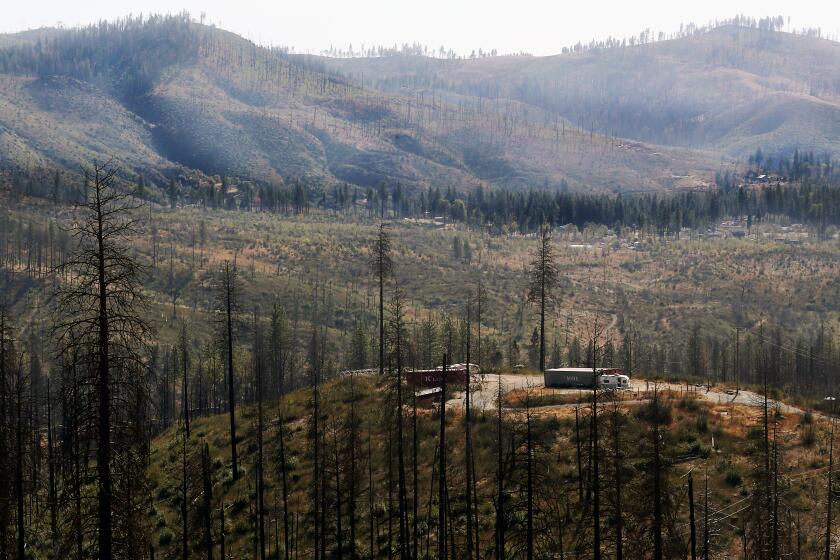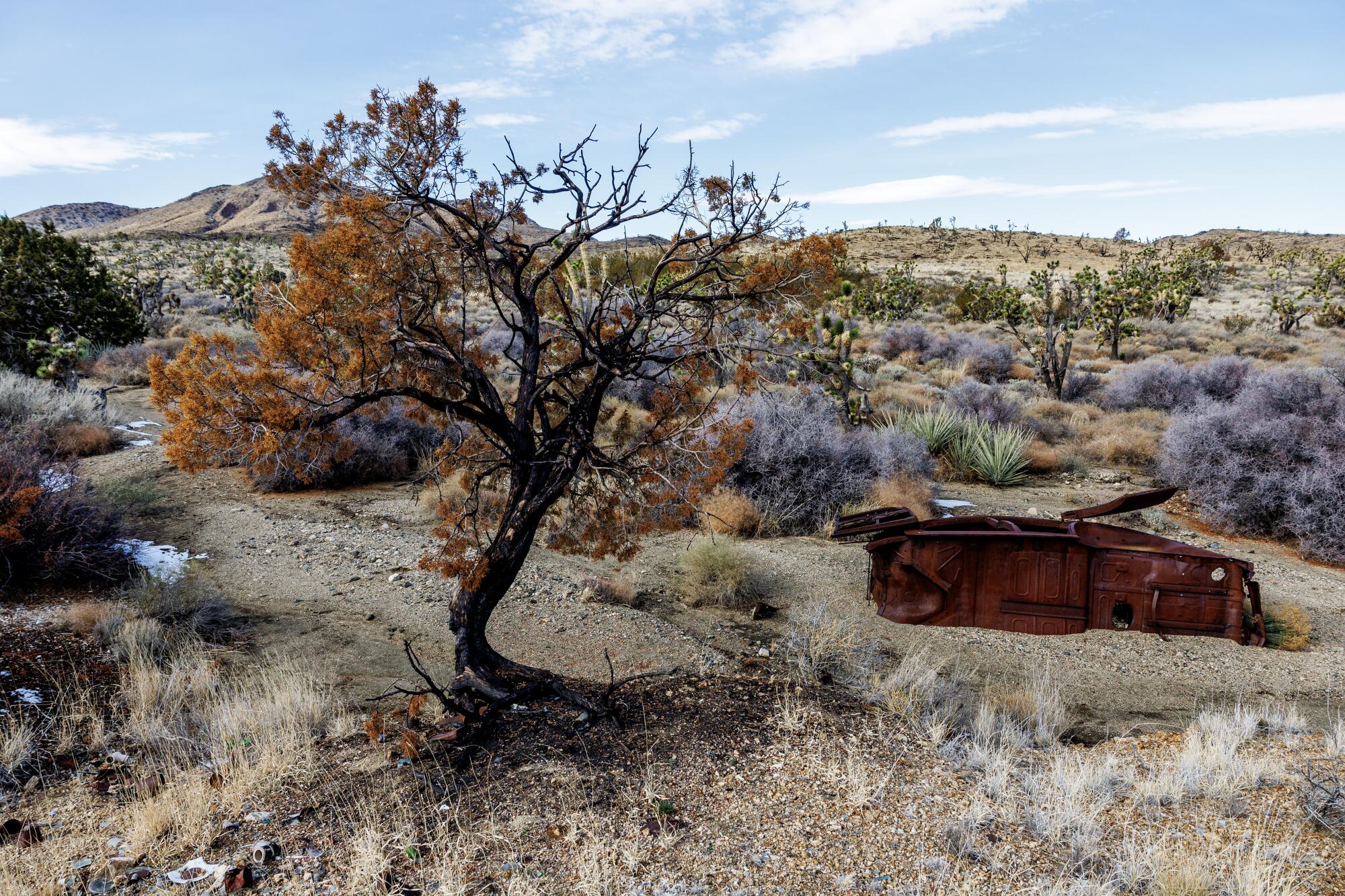
- Share via
MOJAVE NATIONAL PRESERVE, Calif. — The Kousch House stood in the Mojave Desert for nearly a century — first as the residence of a prominent homesteader, then as testament to humanity’s ability to survive harsh and forbidding environments. Now, all that remains of the landmark is a limestone chimney surrounded by charred rubble.
In July, the massive York fire raced through the area, obliterating an old silver mine and other historical structures and torching vast tracks of Joshua trees, whose blackened arms still rise skyward as if in surrender.
The blaze was the largest in a series of wildfires that have become increasingly common in this corner of the desert as climate change brings hotter, drier conditions and more extreme swings in precipitation. Forecasters fear the next few fire seasons could be particularly active for California deserts, as two years of above-normal precipitation have fueled the growth of grasses and small shrubs that will dry out in the spring and summer.
Since 2005, more than 200,000 acres have burned in and around the Mojave National Preserve; fires have destroyed lush pinyon pine and juniper woodlands, desert tortoise habitat and ancient petroglyphs.
For those unaccustomed to watching the desert burn, the new fire regime has come as a shock. But experts say it will grow more pronounced and threatens to transform California’s iconic Mojave Desert, wiping out vestiges of human settlements and hastening the demise of threatened species. It’s also causing park managers and others to question long-held assumptions about wildfire.
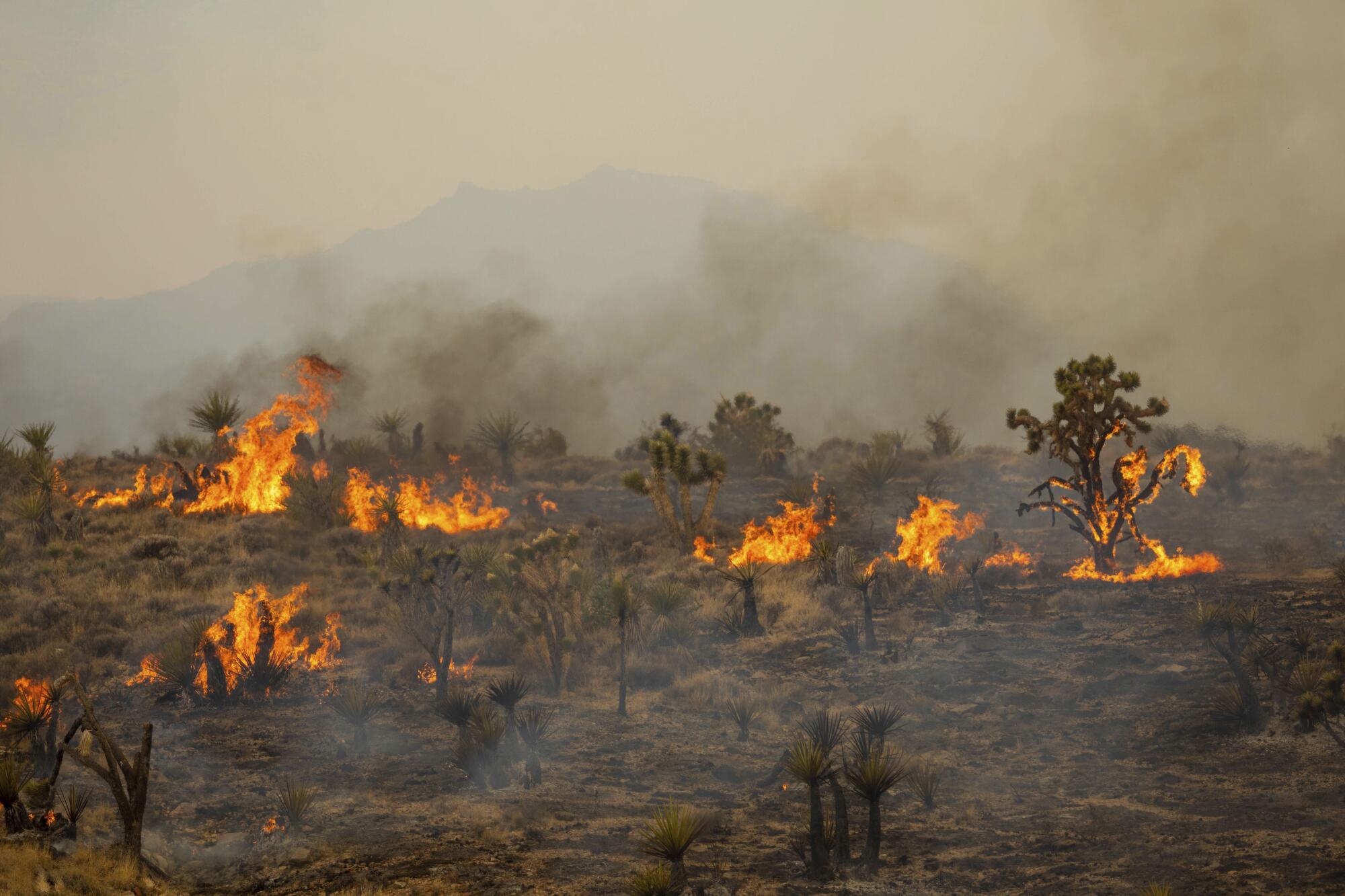
“I think that we totally misunderstand the natural fire regime here,” said Debra Hughson, acting superintendent of the preserve.
Most people experience the Mojave’s widely spaced small shrubs and creosote bushes through the windshield of an air-conditioned car as they drive between Los Angeles and Las Vegas.
One-fifth of all conifer forests in the Sierra are mismatched with the warmer climate and may not survive, according to Stanford University researchers.
But the York fire — and several large fires that preceded it — burned in a remote area in the center of the preserve that ecologist Joseph McAuliffe has dubbed the East Mojave Highlands. This area, which includes the New York and Castle mountains, catches precipitation in both summer and winter.
The summer rains foster growth of native perennial grasses that are also found throughout semi-arid areas of Arizona and New Mexico, said McAuliffe, senior research scientist and director emeritus at the Desert Botanical Garden. Unlike some past fires in the preserve that may have spread due to the growth of invasive plants, the York fire was likely spread predominately by these native grasses, which provide a natural source of fine fuel, he said.
The fire started July 28 in the front yard of a home on an inholding, in what preserve officials described as a spark accident involving power tools.
Conditions were extremely flammable. Two historically dry winters, in 2020 and 2021, had resulted in a die-off of long-living plant species like Joshua trees and junipers, said Jim Andre, conservation botanist and director of the University of California’s Granite Mountains Desert Research Center. Wetter conditions in the summer of 2022 and the following winter weren’t sufficient to revive the dying trees and shrubs but fostered tremendous growth of native perennial grass, he said.
Unprecedented heat and near-record dryness ensured that all those dead plants and perennial grasses were primed to burn. Last July, the average temperature in the area where the fire started was three degrees warmer than the hottest monthly average ever recorded there, Andre said. And the summer monsoon, which typically moderates the threat of desert wildfires, wouldn’t arrive until August.
The flames of the York fire had lingered in Caruthers Canyon, causing perhaps the most extensive damage. The area was once a riotous tangle of green trees and rare plants that more closely resembled a forest than a desert. On a recent winter afternoon, however, the expanse was a monochromatic, rust-colored landscape where bobcats stalked unhurriedly through sparse brush.
These mountains are considered “sky islands,” a poetic term for ranges that rise out of low valleys, fostering plants and animals that couldn’t survive in the lower, hotter areas that surround them. The range incorporates 74 imperiled or rare plant species, some of which are found nowhere else in the state, Andre said.
“There are species in the New York Mountains that their entire distribution in the world is about the size of a residential home,” he said.
Andre has documented remarkable survivorship among those plants in post-fire visits, he said. But it will take time to learn exactly how the ecosystem will recover — and the extent to which invasive species like red brome and cheatgrass will use the disturbance as a foothold to establish new populations.
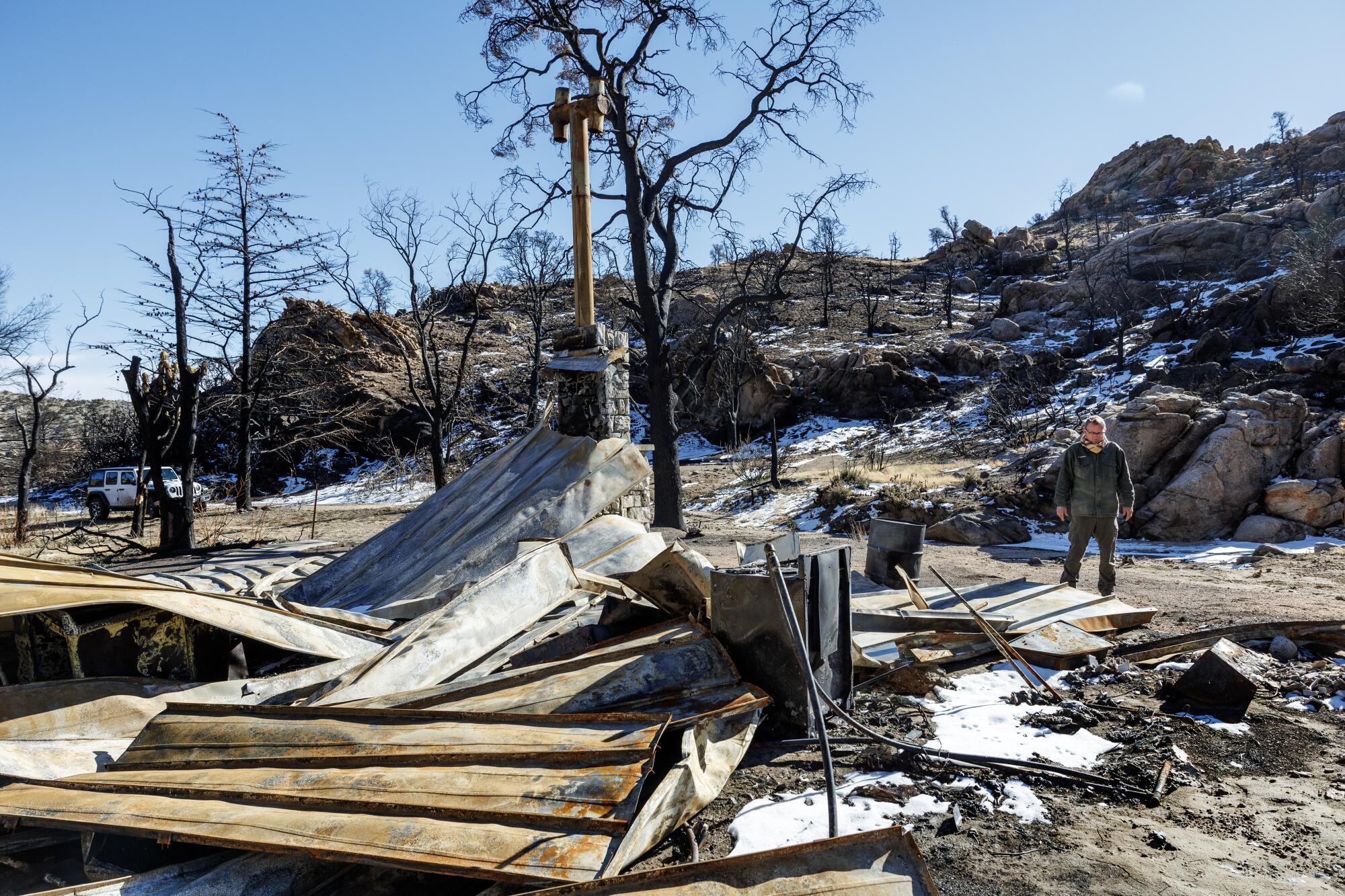
The sprawling maze of rugged canyons and rocky hills is dotted with remnants of various human populations that made homes here at one time or another.
Along with the Kousch House — built in the early 1930s by homesteader John Kousch and eligible to be listed in the National Register of Historic Places — the fire destroyed one of the area’s earliest silver mines, the Sagamore, which dated to 1862 and had barracks that were also eligible for the register.
In a place where the past and present seem to exist in close proximity, it’s likely just a matter of time before more cultural artifacts are wiped out, said Dave Nichols, park archaeologist.
“I’ve been at this park for 20 years, and I’ve seen things disappear that nobody’s ever going to get to see,” Nichols said.

Preliminary estimates based on remote sensed imagery suggest the fire burned more than 1 million Joshua trees, according to U.S. Geological Survey research ecologist Todd Esque.
The destruction came on the heels of the lightning-sparked Dome fire, which in 2020 decimated what was known as the world’s largest and densest Joshua tree forest. The USGS’ most recent modeling puts the toll of that fire at 800,000 Joshua trees — a downward revision of earlier estimates of 1.2 million, attributed to improvements in methodology.
Crews recently planted 30,000 giant sequoia seedlings in the western Sierra, as part of an ongoing effort to restore groves devastated by wildfire.
Joshua trees — two distinct species that are actually varieties of yucca — are slow-growing plants that have a hard time repopulating areas. They lost their biggest natural seed-disperser, the giant ground sloth, to extinction at the end of the Pleistocene Epoch, and the mice that now carry the seeds can’t move them very far.
Preserve staff are hoping to replant some Joshua trees, using lessons they learned after the Dome fire. Those include caging seedlings to protect them from hungry animals, which increases their survival odds almost five-fold, according to Erin Knight, a biological science technician at the preserve.
“If we can maintain a few populations in what they call ‘climate refugia,’ we would consider that a success in terms of maintaining that iconic species,” Hughson said.
One of the ironies of the new desert fire regime is that prior to the arrival of white settlers, the Mojave highlands saw fires on a regular basis, according to McAuliffe, who is using carbon-14 dating to identify times in the past when wildfires killed juniper trees.
However, those fires burned through a very different landscape.
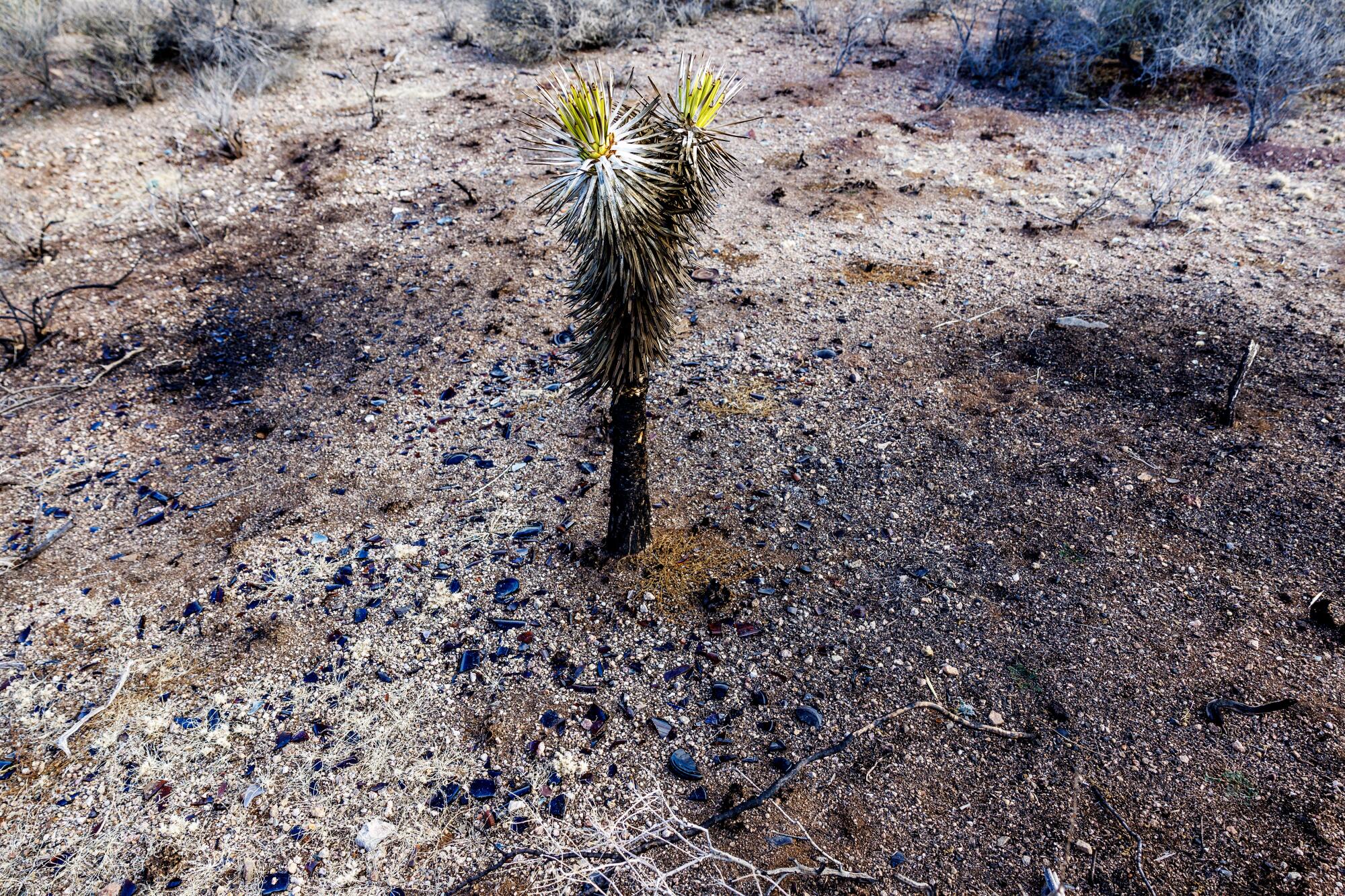
Grasses grew unchecked and provided abundant fuel for lightning-sparked flames. At the same time, Indigenous residents such as the Chemehuevi people — members of the most southern band of the Nuwuvi or Southern Paiute Nation — tended hunting and gathering grounds with fire.
That includes the land in and around the New York Mountains, where the York fire burned.
”I know the Chemehuevis occupied those areas, because we sing about those in our Salt Songs,” said elder Matt Leivas.
The remote area would have been a great spot for gathering pine nuts and hunting for upland game, so whatever Indigenous group occupied the area would naturally have burned the land to get rid of dense underbrush and trigger lush plant growth to attract animals, Leivas said. “I would assume they would be clearing areas and maintaining areas.”

But in the 1800s, miners, ranchers and homesteaders moved into the Mojave, building ephemeral boomtowns like Barnwell and Vanderbilt. They unleashed livestock and burros into the grasslands. They drove out the Chemehuevi. And they suppressed fires, both intentionally and naturally ignited, to protect their towns, mines, railroads and rangelands.
Throughout the 1990s, the native grasses were uniformly grazed down to just a couple of centimeters above the soil surface, McAuliffe said. That led some to wrongly characterize the landscape as shrub or scrub desert — and served to foster a misunderstanding of the east Mojave highlands as a place where wildfires did not naturally occur, he said.
Today, park officials hope that by looking into the past, they can find answers on how to make the desert more resilient to fires. The National Park Service has provided funding for McAuliffe’s research to learn more about fire’s natural role here.
The preserve’s current approach to fire is one of strict exclusion: Wildfires are immediately suppressed throughout its 1.6 million acres, and there is no controlled burning to cull excess vegetation. That’s in part based on the belief that large blazes were once rare, so plants and animals don’t readily recover.
Members of the Southern Sierra Miwuk Nation became the latest Indigenous tribe to watch homes burn despite knowing it could have been avoided.
But Hughson calls this a flawed premise, one that betrays a misunderstanding of both the diverse terrain and of fire’s role here over time.
“We’re basically driving in the dark to a destination that we don’t know anything about because of climate change and the changing fire regime,” Hughson said.
Park officials retired grazing allotments in most of the preserve in 2000, but the practice left behind lasting changes.
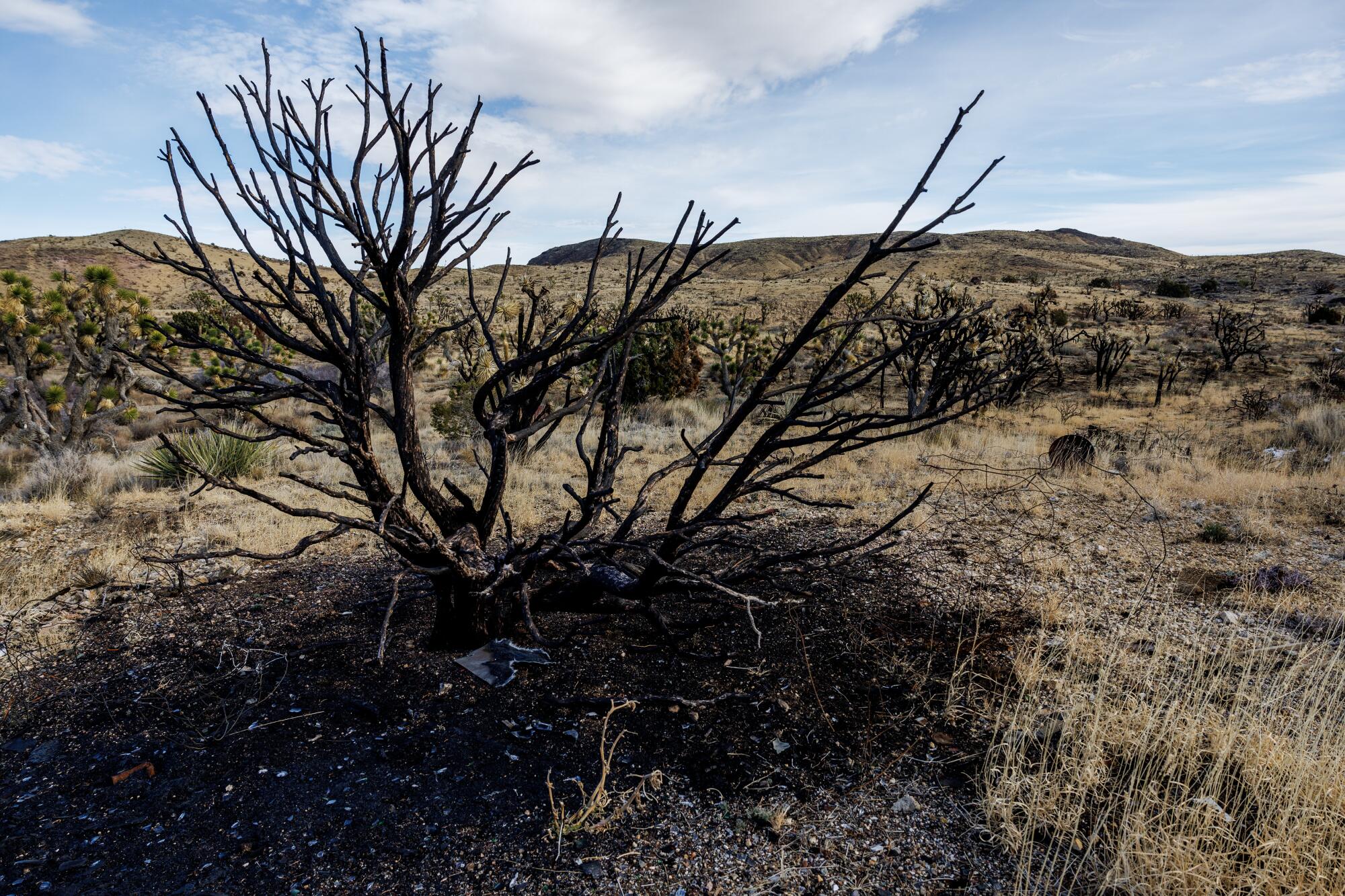
“Between the cattle and the fire suppression, it probably did something to the distribution of Joshua trees, so that the fuel load here is completely unnatural than what it would otherwise be,” Hughson said.
Swaths of the preserve likely ended up with thicker, denser patterns of Joshua trees because cows and sheep like to eat certain plants — particularly grasses — and leave others behind, including unpalatable shrubs like blackbrush that provide shade and nutrients to Joshua tree sprouts, she said.
Studies have shown that heavy grazing can deplete soils around long-lived shrubs so their seeds can’t germinate, rendering them unable to regenerate.
The park service’s overriding ethos when it comes to the preserve is not to intervene in so-called natural processes unless it is necessary to rectify something caused by humans, Hughson said. But she called the idea of natural processes here “wishful thinking.”
“The whole thing we’re looking at is a completely manipulated environment, first by the Indigenous people and then by the Europeans, in different ways,” Hughson said. “And it was probably never really un-manipulated since the time that humanity wound up here doing what we do.
“Nobody knows what it would be like if people hadn’t come here and created whatever we see,” she added. “And nobody knows what it’s going to look like in the future.”
Times staff writer Grace Toohey contributed to this report.
Toward a more sustainable California
Get Boiling Point, our newsletter exploring climate change, energy and the environment, and become part of the conversation — and the solution.
You may occasionally receive promotional content from the Los Angeles Times.
